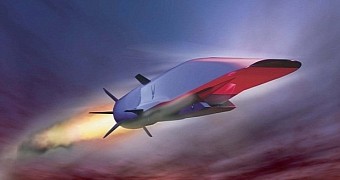In collaboration with the US military's Defense Advanced Research Projects Agency (DARPA, for short), the US Air Force is now hard at work developing a new generation of aircraft it promises will shoot through the sky at five and even up to ten times the speed of sound.
In a recent interview, US Air Force Chief Scientist Mica Endsley said that such hypersonic air vehicles could make their debut no later than 2023.
What with their being astoundingly fast, hypersonic planes like the ones the US Air Force and DARPA now have in the works would mean flying from New York to London in just one hour or from New York to Los Angeles in a measly half an hour.
Except nobody would actually get to travel aboard them as the acceleration would prove too much for the human body to handle. Instead, the US Air Force and DARPA imagine using such aircraft to carry weaponry, sensors or all sorts of other equipment.
Interestingly, the agencies say that, alongside their work on hypersonic jet, they are also developing hypersonic weapons. Hypersonic missiles, to be more precise.
Like the super fast planes that are expected to be revealed by 2023, these missiles will move at a speed five to ten times greater than the speed of sound. Good luck getting out of their way.
“You could then attack defensive targets, those heavily defended or the time-critical targets in a very timely manner - if it's a moving target, before it can move,” said researcher Kenneth Davidson with the US Air Force Research Laboratory, as cited by DM.
It's not just about building the perfect engine
We dare say we can all agree that, when it comes to building a hypersonic plane, its engine is pretty much the centerpiece. Still, there are a few other aspects the US Air Force and DARPA must focus on if they want this project of theirs to succeed.
For starters, the jet must incorporate materials able to withstand the temperature extremes that come with traveling at hypersonic speeds. Besides, the craft's guidance systems must be designed in such ways that they will still work at these speeds.
“There are a bunch a technological challenges that have to be addressed to make a functioning system that will work,” US Air Force Chief Scientist Mica Endsley very eloquently summed up the hurdles scientists and engineers working on this program face.
A couple of years back, in May 2013, a hypersonic vehicle built by Boeing was tested in a flight some 6,000 feet (a little over 1,800 meters) above the Pacific. True, the jet ran out of fuel and plunged in the water after just a few minutes of flight.
However, this test flight, during which the Boeing-made X-51 WaveRider craft reached a speed of about 3,400 miles per hour (nearly 5,500 kilometers per hour) proved hypersonic travel possible. It was a proof of concept, if you will. If you have a couple of minutes to space, check out the video below to see how this flight played out.

 14 DAY TRIAL //
14 DAY TRIAL // 